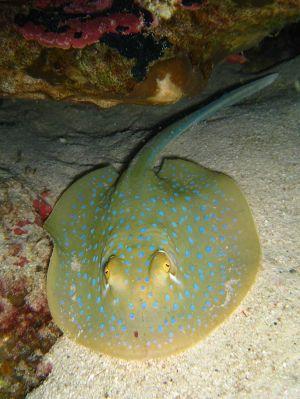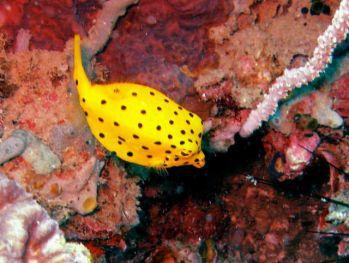 Blue Spotted Stingray (Neotrygon Kuhlii)
Blue Spotted Stingray (Neotrygon Kuhlii)
Photo by Henry and TersiaTurtle Rock at the Similan Islands in Thailand is located at the northwest corner of Island 8. Although some turtles visit the area and are spotted by divers most days, their presence is not the reason behind the naming of this dive site. Instead, a set of rocks at the surface of the water make the shape of a turtle, in some people's opinion. Compared to other Thai diving sites it is magnificent, deep and clear, but compared to other Similan Island diving sites, it is of medium-depth but offers clear visibility, mild currents and a wide range of healthy and diverse marine life.
- Lots of Spotted Garden Eels
- Blue-Spotted Stingrays
- Gentle currents
- Not too challenging
Like its neighbour, Donald Duck Bay, just around the corner, Turtle Rock is a relatively shallow and easy dive site compared to some more extreme sites around the Similan Islands. It faces west, out towards the Andaman Sea, which soon becomes the Indian Ocean. It consists of huge granite boulders which are scattered out from the surface down to depths in excess of 25 metres. On either side of the stack of rocks and boulders, there are fields of hard corals, such as Staghorn, Gorgonian Sea Fans, and some soft corals and anemones. Moving into deeper water and further from 'The Turtle Rock' everything becomes a little sparser, but there's still plenty of life out there. All along the dive site, especially on the north side, there are lots of canyons and a few swimthroughs. These are mostly between a depth of 10 metres and the surface. Night Diving is possible if the currents aren't strong, which they aren't most of the time.
 Yellow Boxfish (Ostracion cubicus)
Yellow Boxfish (Ostracion cubicus)
Thanks to Lyle Turner at the Global Reef ProjectOther than turtles, the most commonly-seen exciting fish seen here are Spotted Garden Eels (Heteroconger hassi) and Blue-Spotted Stingrays (Neotrygon Kuhlii). Both species hang out on the sandy seabed, but react very differently when approached by divers. The stingrays are normally alone and will just up and leave, hoping to be able to come to rest within a few metres, but disappearing completely if they feel harassed. The Garden Eels, however, live in large groups and all hide away in their little holes in the sand. Patient divers who get down low and wait to the side of the field of eels will then see them all come up again when they feel that the coast is clear. Like at most Thai diving sites, there's usually the chance of seeing a Leopard/Zebra Shark (Stegostoma fasciatum) on the sandy bottom, too. Finally, before starting the ascent, divers should look out for Gobies, such as the Red Fire Goby (Nemateleotris magnifica), although they are very small and may have already hidden.
On the way back up, keep an eye open for medium-size bony fish such as Oriental Sweetlips (Plectorhincus vittatus), Titan Triggerfish (Balistoides viridescens), Groupers (Epinephelinae), Parrotfish (Scarinae) and Trevally (Carangidae). Smaller species which are photogenic and not too difficult to spot are Lionfish (Pterois), Angelfish (Pomacanthidae) and Boxfish (Ostraciidae). In nooks and crannies at Turtle Rock there are always Moray Eels (Gymnothorax) waiting to come out and hunt at night. The Honeycomb/Tasselite Moray Eel (Gymnothorax favagineus) is especially attractive and often seen here. Invertebrates such as sea stars, nudibranchs, sea cucumbers and sea urchins can be seen during the day, with small shellfish such as shrimps and various crabs being possible to find. At night, though, things are different, with thousands of little eyes visible as the more active shellfish come out in the dark to search for food. Larger crabs and lobsters are abundant on some night dives.
No western Similan Island diving review would be complete with the mention of the two filter feeding giants that most PADI divers are excited to see. The location of Turtle Rock is ideal out on the west side of Island 8 for such sightings, although they usually swim in slightly deeper water. Whale Sharks (Rhincodon typus) and Manta Rays (Manta alfredi) could pop by for visit at any time during the diving season so Similan divers here at Turtle Rock should always keep one eye on the open blue waters to the west, and if they hear any dive tanks banging, it's usually a signal from their Divemaster or another group.
The only access to Turtle Point at Similan 8 is via speedboat day trip or liveaboard cruise. Several options are available with various dives per trip and many different levels of luxury and price. We are able to take bookings for any Similans diving trip.



